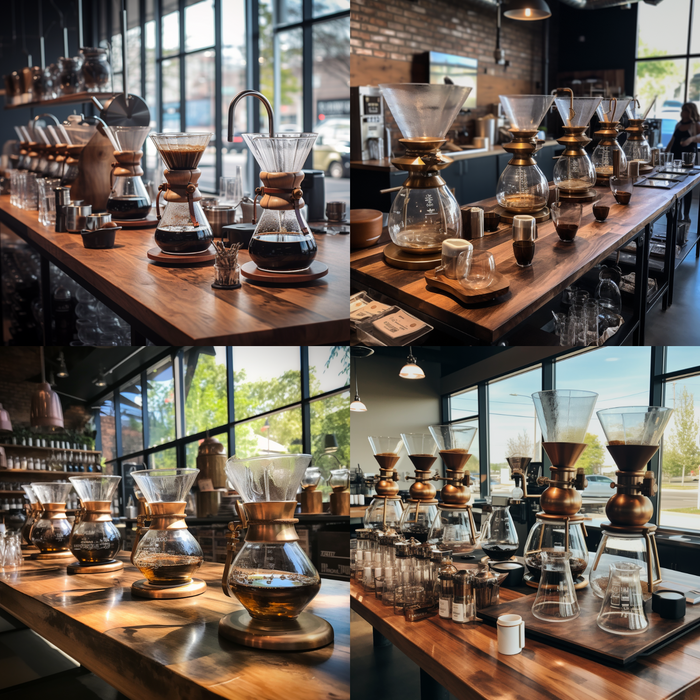
Blog posts
-
 Attending a roasting class at Rare Earth is a unique experience. You'll be working with freshly roasted beans, which makes a significant difference in flavor. It's an immersive experience that combines learning with sensory enjoyment.Read now
Attending a roasting class at Rare Earth is a unique experience. You'll be working with freshly roasted beans, which makes a significant difference in flavor. It's an immersive experience that combines learning with sensory enjoyment.Read now -

The Art of Coffee Tasting: Rare Earth Coffees Tasting Class, A Beginner's Guide.
Coffee tasting is an enriching experience that transforms how you perceive and enjoy coffee. Whether you're a casual drinker or an aspiring connoisseur, Rare Earth's coffee tasting class is a perfect starting point. Here, amidst the aroma of freshly roasted beans, you'll not only taste coffee but also immerse yourself in the culture and craft that makes each cup special. Embark on this flavorful journey and discover the art and science behind your favorite brew.Read now -

What You Need to Know About Home Coffee Brewing: 7 Must-Have Tools
Read nowWith these seven essential tools, you'll be well on your way to brewing exceptional coffee right in the comfort of your own home. Each tool plays a vital role in the journey from bean to cup, ensuring that every sip is as satisfying as the last.
Explore our selection of coffee beans and brewing tools at Rare Earth Coffee, and share your home brewing adventures with us on social media. We love seeing how our community brews their perfect cup.

Discovering the World's Coffee Flavors: A Comprehensive Guide to Global Growing Regions and Their Unique Profiles
Coffee is a beverage enjoyed by millions of people around the world. Its rich and complex flavors are not only derived from the type of beans used but also from the unique characteristics of the regions in which they are grown. This fascinating world of flavor is the result of numerous factors, including climate, soil composition, altitude, and processing methods.
In this comprehensive guide, we will take you on a journey through the diverse coffee-growing regions of the world, exploring their distinct flavor profiles and uncovering the secrets behind the beans that make each cup of coffee unique.
1. Central and South America: Bright Acidity and Balanced Flavors
Central and South America are known for producing some of the world's most sought-after coffees, prized for their bright acidity, balanced flavors, and clean finish. Let's delve into some of the region's most notable coffee-producing countries:
a. Colombia
As the third-largest coffee producer in the world, Colombia boasts a diverse range of coffee flavors due to its varied microclimates and regions. Colombian coffee is typically characterized by its medium body, bright acidity, and fruity, nutty, and caramel notes.
b. Brazil
Brazil is the world's largest coffee producer, accounting for around one-third of global coffee production. Brazilian coffee is known for its low acidity, medium to full body, and flavors that range from nutty and chocolatey to fruity and sweet, depending on the region and processing method.
c. Guatemala
Guatemalan coffee is highly regarded for its complexity and depth of flavor, thanks to the country's high-altitude growing regions and fertile volcanic soil. Guatemalan coffee often features bright acidity, a medium to full body, and flavors that can include chocolate, caramel, and citrus.
d. Costa Rica
Costa Rican coffee is celebrated for its bright acidity, medium body, and fruity, citrusy flavors. The country's dedication to sustainable coffee farming practices and its focus on quality over quantity contribute to its reputation as a producer of exceptional coffee.
2. Africa: Floral, Fruity, and Complex
African coffee is often characterized by its bold, complex flavors, with floral and fruity notes that can range from berries and citrus to tropical fruits. Here are some notable African coffee-producing countries:
a. Ethiopia
Widely considered the birthplace of coffee, Ethiopia is known for producing some of the world's most distinctive and sought-after beans. Ethiopian coffee can be divided into three main categories: Yirgacheffe, with its floral, citrusy, and tea-like qualities; Harrar, which offers fruity, wine-like flavors; and Sidamo, which features a balance of fruity and spicy notes.
b. Kenya
Kenyan coffee is renowned for its bright acidity, full body, and intense, wine-like flavors. The country's high-altitude growing regions, combined with its unique processing methods, contribute to the distinct flavor profile of Kenyan coffee, which often features notes of blackcurrant, grapefruit, and tomato.
c. Rwanda
Rwandan coffee has gained recognition in recent years for its bright acidity, medium body, and complex flavors. Rwandan coffee often showcases fruity and floral notes, such as red berries, stone fruit, and jasmine, as well as a hint of spiciness.
3. Asia and the Pacific: Earthy, Spicy, and Full-Bodied
Asian and Pacific coffees are known for their earthy, spicy, and full-bodied flavors, which can be attributed to the region's volcanic soil and unique processing methods. Here are some standout coffee-producing countries in the region:
a. Indonesia
Indonesian coffee is famous for its low acidity, full body, and earthy, spicy flavors.
Some of the most notable Indonesian coffee-producing islands include Sumatra, Java, and Sulawesi.
i. Sumatra
Sumatran coffee is known for its low acidity, full body, and complex, earthy flavors, with notes of chocolate, herbs, and sometimes even a hint of cedar. The unique wet-hulling processing method used in Sumatra contributes to the distinct taste of the region's coffee.
ii. Java
Java is one of the oldest and most famous coffee-producing regions in Indonesia. Javanese coffee typically has low acidity, a medium to full body, and flavors that range from earthy and spicy to sweet and fruity, depending on the processing method used.
iii. Sulawesi
Sulawesi coffee, particularly from the Toraja region, is prized for its medium to full body, moderate acidity, and complex flavor profile. Sulawesi coffee often features notes of dark chocolate, ripe fruit, and spices, with a smooth, velvety mouthfeel.
b. Papua New Guinea
Papua New Guinea (PNG) is a relatively small coffee producer, but its beans have gained a reputation for their bright acidity, medium body, and fruity, sometimes wine-like flavors. The country's diverse microclimates and volcanic soil contribute to the unique flavor profile of PNG coffee, which can include notes of tropical fruit, citrus, and chocolate.
c. India
Indian coffee is often characterized by its medium acidity, medium to full body, and earthy, spicy flavors. Some of the most famous coffee-growing regions in India include the states of Karnataka, Kerala, and Tamil Nadu.
i. Karnataka
Karnataka, home to the well-known Mysore and Monsooned Malabar coffees, produces beans with low acidity, a medium to full body, and flavors that range from earthy and spicy to sweet and nutty.
ii. Kerala
Kerala, known for its Robusta coffee production, offers beans with low acidity, a full body, and strong, earthy flavors.
iii. Tamil Nadu
The Nilgiri Hills in Tamil Nadu are known for producing coffee with bright acidity, a medium body, and fruity, floral, and spicy flavors.
The world of coffee is incredibly diverse and complex, with a wide range of flavors that are influenced by the unique characteristics of each growing region. From the bright acidity and balanced flavors of Central and South American coffees to the bold, fruity, and floral notes of African beans, and the earthy, spicy, full-bodied profiles of Asian and Pacific coffees, there is a world of flavor to explore and enjoy.
By understanding the unique coffee profiles of different growing regions, you can expand your palate and deepen your appreciation for the incredible range of flavors that the humble coffee bean has to offer. So, embark on a journey of discovery and savor the tastes of the world, one cup at a time.


Leave a comment